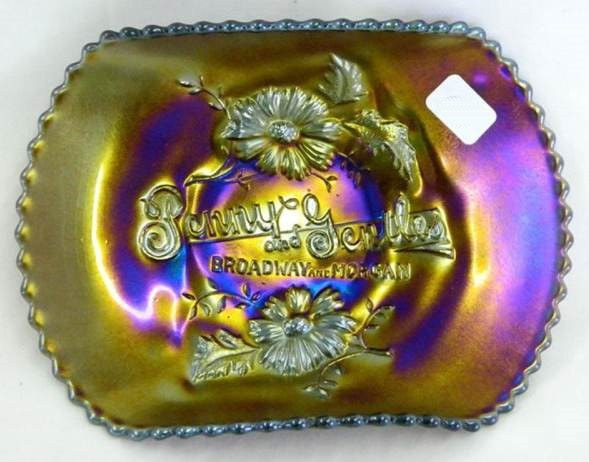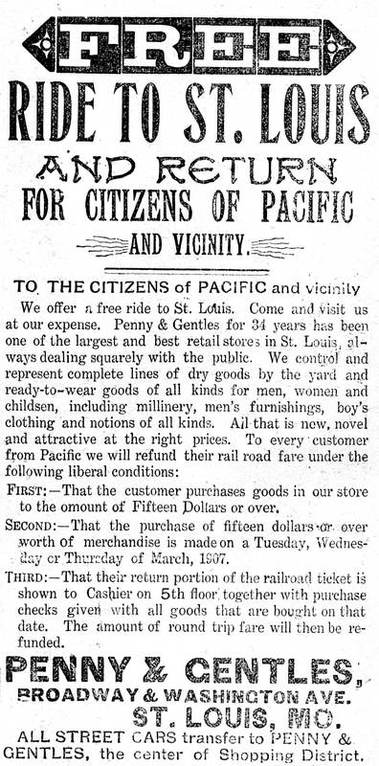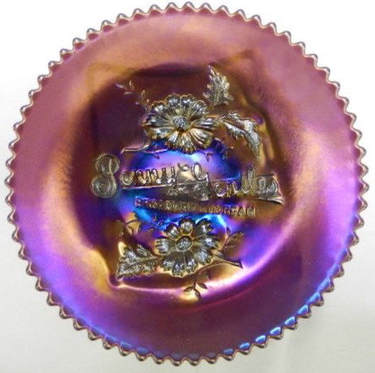Penny and Gentles - The Story Behind The Glass
Based on updated and new research carried out since our original work in 2014.
Advertising (Lettered) pieces are a researcher’s dream! The name of the shop or institution is spelled out before our very eyes. So it’s easy then, surely? Definitely not! There’s no getting away from the fact that it does take a huge amount of effort, sheer determination and application.
|
John Resnik (the original researcher of many Carnival Lettered pieces in the 1980s) spent years delving through the public library system, while today we have the wealth of the world wide web. In fact, researching doesn’t take less time using the world wide web, it can easily take even more time, though it does save on fuel costs! It also enables the researcher to obtain a bigger picture and the wider economic and social context of the period when they were made.
So what’s the story behind "Penny and Gentles of Broadway and Morgan"? Penny and Gentles double hand-grip plate in amethyst, Northwood. Only one
example is known in this shape. Courtesy Seeck Auctions. Penny and Gentles was a thriving, relatively large “Dry Goods” department store, in St Louis, Missouri, selling fabrics, clothing, kitchenware, a wide range of textile fabrics and even sheet music. The original store opened in 1873. In 1891, a disastrous fire that had begun in the Penny and Gentles store decimated the entire block and adjoining buildings. Contemporary reports indicate that Penny and Gentles suffered a quarter of a million dollar loss on stock and building combined. As well as the financial cost, there was a human side to this disaster. Thanks to Hb Lammers for this additional information reported in the Tribune-Republican (Union, Missouri) of 20 Nov 1891: "All around the block were rows and groups of young women and girls who had reported for work at the usual hour, only to find their positions gone up in smoke like the goods they were expected to sell. Many of them were tearfully bemoaning the prospect of no work and no pay for some time to come and the Christmas season right upon them." |
Penny & Gentles sales promotion in the St. Louis press, 1907.
|
Nine years later, in 1900, there was another fire (which also started in Penny and Gentles store) which destroyed four blocks The local newspaper, The Advertiser-Courier reported "nearly two million dollars’ worth of St. Louis business property was burned”. An eye witness account from a man in the dentist’s opposite stated that “the whole front of the Penny and Gentles building on the second floor was blown out”. An explosion was felt to have been the cause!
Since the late 1800s, the commercial district of St. Louis had been home to several competing “Dry Goods” stores, and after St. Louis hosted the World’s Fair in 1904, there were some substantial investment and construction projects to create “state-of-the-art” department stores that were geared for mass retailing.
There were three major stores offering more and more features to attract shoppers. The largest, the Grand-Leader / Stix, Baer and Fuller Dry Goods Co., offered something for everyone, “rich and poor”: they had their “Bargain Basement” to “attract the bargain hunter”, but they also had newfangled escalators to steer their “suburban, professional” customers up though the pricier, “exclusive trade” sections of the store. They offered “all the comforts of home” including a free telephone service, private waiting rooms, hairdressers, lavatories and even “hospital rooms” staffed by a doctor and nurse. There was an immense dining room that comfortably seated 750 people!
Nine years later, in 1900, there was another fire (which also started in Penny and Gentles store) which destroyed four blocks The local newspaper, The Advertiser-Courier reported "nearly two million dollars’ worth of St. Louis business property was burned”. An eye witness account from a man in the dentist’s opposite stated that “the whole front of the Penny and Gentles building on the second floor was blown out”. An explosion was felt to have been the cause!
Since the late 1800s, the commercial district of St. Louis had been home to several competing “Dry Goods” stores, and after St. Louis hosted the World’s Fair in 1904, there were some substantial investment and construction projects to create “state-of-the-art” department stores that were geared for mass retailing.
There were three major stores offering more and more features to attract shoppers. The largest, the Grand-Leader / Stix, Baer and Fuller Dry Goods Co., offered something for everyone, “rich and poor”: they had their “Bargain Basement” to “attract the bargain hunter”, but they also had newfangled escalators to steer their “suburban, professional” customers up though the pricier, “exclusive trade” sections of the store. They offered “all the comforts of home” including a free telephone service, private waiting rooms, hairdressers, lavatories and even “hospital rooms” staffed by a doctor and nurse. There was an immense dining room that comfortably seated 750 people!
|
Penny and Gentles 6 inch plate in amethyst. There is only
one known example. Photo courtesy of Dave Doty. |
Unfortunately by that time, Penny and Gentles was not in this league – it was a smaller player trading from a more antiquated building – but it had to find a way to compete. The owners had a long tradition of offering free gifts and unusual promotions to drive up their sales. Indeed, one of their 1903 ads began with this novel line: "We don’t wish to startle you too much, so will explain”. The ad went on to state that they were giving away a free lady’s suit jacket when the customer purchased the matching skirt. “Who but Penny & Gentles would make such an offer?” Customers even got “tickets to Forest Park Highlands Amusement Park with every purchase” completely free too. In 1907, Penny and Gentles ran another innovative sales promotion, in the St. Louis press - their actual ad is shown above - offering free travel to their store, provided that the journeys were made mid-week and that purchases were over $15. The ad was placed only a year or so after the opening of the ground-breaking Grand-Leader store which had boasted "High Ideals" from "The Fastest Growing Store in America". We don’t know the date of this rare Northwood advertising piece for certain. However, thanks to research into local newspaper archives, Hb Lammers has found that Penny and Gentles moved to the Broadway and Morgan address in 1909. The store also went through a financial restructuring and in 1914 had a grand "re-opening" of sorts at the same address. So either of these two dates is possible for the commemorative, as both of them coincide with Carnival production at Northwood. |
There are intriguing and (so far) unanswered questions.
Why are there so few of these advertising pieces to be found today? Our understanding is that just two are reported - one in the handgrip shape and one as a regular small plate - both of which are pictured on this page. Could it be that only a few samples were made, and the owners of Penny and Gentles didn't actually place a larger order? For a company that gave away free jackets, free tickets to the Amusement Park and books of 100 labels free to every purchaser of a dozen Mason Jars, the unusual and decorative Carnival Advertising plates would surely have been a part of Penny and Gentles' marketing strategy.
One possibility is that the pieces were intended as part of a sales “push” by the company to regain ground on its larger rivals for the 1914 "re-opening", but the owners decided against them for cost reasons - we know that the business was stretched financially at that time.
And there is also the issue of the address on of the store that was used on the commemorative (Broadway and Morgan). The store was at Broadway and Washington Ave. in 1907 (as the ad above shows), and contemporary reports show that Washington Ave. carried far more prestige (it was the address of the Grand-Leader store). Maybe the owners of Penny and Gentles decided not to draw attention to the fact that they had moved to a less attractive address on on Broadway and Morgan?
Ultimately, we may never know the reason for the rarity of this advertising piece.
Read more of The Stories Behind The Glass in Carnival Glass Times


